Konica Minolta Freedom Zoom Explorer EX Handleiding
Konica Minolta
Niet gecategoriseerd
Freedom Zoom Explorer EX
Bekijk gratis de handleiding van Konica Minolta Freedom Zoom Explorer EX (4 pagina’s), behorend tot de categorie Niet gecategoriseerd. Deze gids werd als nuttig beoordeeld door 243 mensen en kreeg gemiddeld 3.9 sterren uit 122 reviews. Heb je een vraag over Konica Minolta Freedom Zoom Explorer EX of wil je andere gebruikers van dit product iets vragen? Stel een vraag
Pagina 1/4

Thank you for your purchase of a Minolta camera. This camera is
equipped with functions to suit all your photographic needs. Before
using your new camera, please take the time to read through this
instruction manual for it contains information important to the proper
use and care of your camera.
This device complies with Part 15 of the FCC Rules. Operation is subject to the following two conditions:
(1) This device may not cause harmful interference, and (2) this device must accept any interference
received, including interference that may cause undesired operation. Changes or modications not
approved by the party responsible for compliance could void the user's authority to operate the
equipment. This equipment has been tested and found to comply with the limits for a Class B digital
device, pursuant to Part 15 of the FCC Rules. These limits are designed to provide reasonable protection
against harmful interference in a residential installation. This equipment generates, uses and can radiate
radio frequency energy and, if not installed and used in accordance with the instructions, may cause
harmful interference to radio communications. However, there is no guarantee that interference will not
occur in a particular installation. If this equipment does cause harmful interference to radio or television
reception, which can be determined by turning the equipment o and on, the user is encouraged to try to
correct the interference by one or more of the following measures:
• Reorient or relocate the receiving antenna.
• Increase the separation between the equipment and the receiver.
• Connect the equipment to an outlet on a circuit dierent from that to which the receiver is connected.
• Consult the dealer or an experienced radio/TV technician for help.
This Class B digital apparatus meets all requirements of the Canadian Interference-Causing Equipment
Regulations.
This mark on your camera certies that this camera meets the requirements of the EU
(European Union) concerning interference causing equipment regulations. CE stands for
Conformité Européenne (European Conformity).
NAMES OF PARTS
FRONT
1. Shutter-release button
2. Date buttons (DATE model only)
3. Data panel
4. Subject-program selector
5. Self-timer/Drive-mode button
6. Flash-mode button
7. Flash*
8. Back-cover release
9. Viewnder window*
10. Metering window*
11. Lens*
12. Self-timer/Remote-control lamp
14. Flash lamp (orange)
15. Focus lamp (green)
16. Viewnder*
17. ON/OFF button
18. Zoom control
19. Battery cover
20. Strap eyelet
21. Tripod socket
22. Rewind button
23. Film window
24. Back cover
BACK
DATA PANEL
1. Flash-mode indicator
2. Self-timer indicator
3. Continuous-drive indicator
4. Remote-control indicator
5. Date/Time display (date model only)
6. Low-battery symbol
7. Frame counter
8. Film-transport signals
9. Film-cartridge mark
10. Landscape/Night View mode
indicator
11. Night Portrait mode indicator
12. Close-up mode indicator
13. Subject-program pointer
1. Focus lamp (green)
Glows: Focus conrmed
Blinks: Subject too close
2. Flash lamp (orange)
Glows: Flash will re
Blinks quickly: Flash charging
Blinks slowly: Camera-shake warning
3. Focus frame
4. Close-framing guides
VIEWFINDER
©1997 Minolta Co., Ltd. under the Berne Convention and
Universal Copyright Convention
9222-2445-11 NI-C909 Printed in China
13. Autofocus windows/Remote-control receiver*
*Do not touch
EInstruction Manual
FOR PROPER AND SAFE USE
Read and understand all warnings and cautions before using this product.
WARNING
Batteries may become hot or explode due to improper use.
• Use only the batteries specied in this instruction manual.
• Do not install the batteries with the polarity (+/–) reversed.
• Do not subject batteries to re or high temperatures.
• Do not attempt to recharge, short, or disassemble.
• Tape over lithium battery contacts before disposal. Follow local codes
for battery disposal.
Use caution, accidents may occur when using this product near young
children.
Keep batteries or things that could be swallowed away from young
children. Contact a doctor immediately if an object is swallowed.
Immediately remove the batteries and discontinue use if...
• the camera is dropped or subjected to an impact in which the interior is
exposed.
• the product emits a strange smell, heat, or smoke.
The lens retracts when the camera is turned o or Auto Power O is
activated. Touching the lens barrel while it is retracting may cause injury.
Do not disassemble. Electric shock may occur if a high voltage circuit
inside the camera is touched. Take your camera to a Minolta Service
Facility when repairs are required.
TECHNICAL SPECIFICATIONS
Lens: 28-75mm f/3.5-8.9 power zoom lens with 4 elements in 4
groups
Focusing: 3-beam, active infrared autofocus system with focus lock;
Focusing range: 0.4m - (16 in. - ), Close-up: 0.4m - 1.0∞ ∞
(16 in. - 3.3 ft.); Maximum magnication 1/4.3X
Exposure: Center-weighted metering; Metering range (ISO 100):
28mm: EV 2.6 - 17, 75mm: EV 3.3 - 17; Film speed range:
Automatic setting for DX-coded lm ISO 25-3200 in 1EV
steps
Film transport: Auto advance to rst frame, auto rewind, auto threading,
manual start of rewind possible; continuous drive: 1.2
sec./frame (without ash)
Flash: Retractable, built-in ash, ashmatic with intensity control;
Recycling time: approx. 0.3 - 7 sec.; Range (ISO 100): 28mm:
0.4 - 5.9m (16 in.- 19.4 ft.), 75mm: 0.4 - 2.3m (16 in. - 7.5 ft.)
Viewnder: Real-image zoom; Diopter (subject at 3m/10 ft.): -1 diopter
Battery: One 3-volt CR123A or DL123A lithium battery; Battery
performance: Approx. 13 rolls (24 exp. roll w/ 50% ash)
Dimensions: 121 x 66.5 x 44mm (4-3/4 x 2-5/8x 1-3/4 in.)
Weight: 245g (8.64 oz.)
Specications are based on the latest information available at the time of printing
and are subject to change without notice.
OPERATING TEMPERATURE AND CONDITIONS
• This camera is designed for use for -10 to 40°C (14 to 104°F).
• At colder temperatures, the data panel response time will be slow; at
higher temperatures, the display will temporarily darken, but will
restore when the temperature normalizes.
• Never subject your camera to extreme humidity.
• To prevent condensation from forming, place the camera in a sealed
plastic bag when bringing it from the cold exterior to a warm building.
Allow it to come to room temperature before removing it from the bag.
• When photographing in cold weather, we recommend that you keep
the camera and spare batteries inside your coat to keep them warm
when you are not shooting. Cold batteries will regain some of their
charge when they warm up.
• This camera is not waterproof, dust-proof, or sand-proof; take care
when using it at the beach or near water. Costly or irreparable damage
may occur.
Minolta Co., Ltd. 3-13, 2-Chome, Azuchi-Machi, Chuo-Ku, Osaka 541-8556, Japan
Minolta GmbH Kurt-Fischer-Strasse 50, D-22923 Ahrensburg, Germany
Minolta France S.A. 365 Route de Saint-Germain, F-78420 Carrieres-Sur-Seine, France
Minolta (UK) Limited 7 Tanners Drive, Blakelands, Milton Keynes, MK14 5BU, England
Minolta Austria Ges. m.b.H. Amalienstrasse 59-61, A-1131 Wien, Austria
Minolta Camera Benelux B.V. Zonnebaan 39, P.O. Box 6000, NL-3600 HA Maarssen, The Netherlands
Belgium Branch Prins Boundewijnlaan 1, B-2550 Kontich, Belgium
Minolta (Schweiz) AG Riedstrasse 6, CH-8953 Dietikon, Switzerland
Minolta Svenska AB Albygatan 114, S-171 54 Solna, Sweden
Finland Branch Niittykatu 6 PL 37, SF-02201 Espoo, Finland
Minolta Portugal Limitada Av. do Brasil 33-A, P-1700 Lisboa, Portugal
Minolta Corporation
Head Office 101 Williams Drive, Ramsey, New Jersey 07446, U.S.A.
Los Angeles Branch 11150 Hope Street Cypress, CA 90630, U.S.A.
Minolta Canada Inc.
Head Office 369 Britannia Road East, Mississauga, Ontario L4Z 2H5, Canada
Vancouver Branch 230-3771 Jacombs Road, Richmond, B.C. V6V 2L9, Canada
Minolta Hong Kong Limited Room 208, 2/F, Eastern Center, 1065 King’s Road, Quarry Bay, Hong Kong
Minolta Singapore (Pte) Ltd. 10, Teban Gardens Crescent, Singapore 608923
Shanghai Minolta Optical
Products Co., Ltd. 368 Minolta Road, Songjiang, Shanghai, China

Step
Step
Step
Step
Step
Attach the strap as shown.
Your camera uses one 3-volt CR123A or DL123A lithium
battery to supply power for all camera operations.
➀Open the battery cover using a coin or
similar object.
➁Insert the battery according to the + and –
marks inside the battery chamber and snap
the cover closed.
• Before removing an old battery, make sure the camera
is o.
If the blinking low-battery symbol appears in the
data panel with the other indicators, you can still
use the camera, but the battery will have to be
replaced soon.
If the blinking low-battery symbol appears alone
(date model: only the date/time display with the
blinking low-battery symbol), you cannot use the
camera until you replace the battery. The shutter
cannot be released.
Use only 35mm, DX-coded film rated ISO 25 to
3200. ISO 400 or higher is recommended for taking
telephoto photographs or pictures in low light.
• Do not use Polaroid instant 35mm film. Winding
problems may occur.
➀Slide the back-cover release down to open
the back cover and place the lm cartridge
into the lm chamber.
• Always load and unload the film in subdued light.
➁Extend the lm tip to the “FILM TIP” mark,
making sure it lays at.
➂Close the back cover.
• The lm automatically advances to the rst frame and
appears in the data panel.
• If the lm has been loaded improperly, will blink in the
data panel and the shutter will remain locked. Open the
back cover and repeat the loading procedure.
➀Press the ON/OFF button to turn the
camera on.
• The ash will pop up and the lens barrel will extend.
• Press the ON/OFF button to turn the camera o.
• To conserve power, the camera automatically turns o if
it is not operated for more than eight minutes. The lens
barrel and ash will retract.
• Do not obstruct the lens while it is retracting.
FULL AUTO OPERATION - CONTINUED
➁Look through the viewnder and press the
W side of the zoom control to move toward
wide angle or the T side to move toward
telephoto.
• Do not hold the lens barrel; focus may not be accurate.
• Make sure your subject is at lease 0.4 m(16 in) from the
camera.
➂Align your subject within the focus frame
and press the shutter-release button
partway down.
➃When the green focus lamp glows, gently
press the shutter-release button all the way
down to take the picture.
• The ash will automatically re in low light.
• The lm automatically advances to the next frame.
Close-framing Guides
When your subject is closer than 1.2m (4 ft.) at
75mm, rst lock focus on your subject by pressing
the shutter-release button partway down, then
recompose your picture within the close-framing
guides.
• If the green focus lamp blinks, your subject is closer
than the minimum focusing distance of 0.4m (16 in.) and
will not be in focus. The shutter cannot be released.
• If the subject is very close to the camera, the green
focus lamp will glow, but the picture will not be in focus.
When your subject is located outside the focus
frame, you can rst lock focus on your subject, then
recompose the picture as desired.
➀Align the subject within the focus frame and
press the shutter-release button partway
down until the green focus lamp glows.
The lm will rewind automatically after the last
frame has been exposed.
When appears and blinks in the data panel,
open the back cover and remove the lm.
To begin rewind before the end of the roll, turn the
camera on and gently press the rewind button
using a pen or similar object.
LOW BATTERY SYMBOL
CLOSE-FRAMING
➁Without lifting your nger, recompose the
picture then press the shutter-release button
all the way down to take the picture.
FOCUS LOCK
MANUAL REWIND
If rewind stops before the lm has been completely rewound and all indicators
blink, DO NOT OPEN THE BACK COVER. Insert a fresh battery then press the
rewind button.
ATTACHING THE STRAP
INSERTING THE BATTERY
LOADING THE FILM
FULL AUTO OPERATION
REWINDING THE FILM

Autoash mode ( ), autoash with red-eye
reduction ( ), manual ll-ash ( ) or
ash cancel ( ) can be selected.
Press the ash-mode button until the desired
indicator appears in the data panel.
The sequence is as shown.
• When you turn the camera on, the built-in flash is set to
autoflash or autoflash with red-eye reduction, whichever
mode was last used.
The range of the built-in ash depends
on the lm speed and focal length you
are using. To ensure proper exposure,
make sure your subject is positioned
within the ash range.
• Do not hold the ash down; the shutter may not
release.
• For vertically framed pictures, hold the camera so the
ash is on top.
While pressing the shutter-release button partway down:
• The orange ash lamp will glow whenever the built-in
ash is on.
• When the orange ash lamp blinks slowly, your scene is
too dark for a sharp hand-held picture. Use ash or
place the camera on a tripod.
• When the orange ash lamp blinks rapidly, the ash is
charging. Wait until it glows steadily, then take the
picture. Flash recharge time is approximately 0.3 to 7
seconds.
In this flash mode, the flash will fire a few short
bursts before the main flash burst to reduce the
“red-eye” effect which occurs when photographing
people in low light.
Press the flash-mode button until appears
in the data panel, then take the picture.
• Before taking the picture, warn your subjects that the
ash will re a few short bursts before the picture is
taken.
• The orange ash lamp will blink indicating preash.
The ash will re with every shutter release
regardless of lighting. This can be used to reduce
harsh, unattering shadows on your subject’s face
or illuminate your subject when it is back-lit.
RED-EYE REDUCTION MODE
Press the ash-mode button until appears
in the data panel, then take the picture.
With ash-cancel, the ash will not re. This mode
should be used when photographing twilight
scenes or subjects that are beyond the ash
range.
Press the ash-mode button until appears
in the data panel, then take the picture.
• When the ash is cancelled, shutter speeds may be
slow. Placing your camera on a tripod is recommended.
MANUAL FILL-FLASH MODE
In autoflash mode,the flash will fire in low light.
AUTOFLASH MODE
FLASH CANCEL MODE
The self-timer delays release of the shutter for
approximately 10 seconds after the shutter-release
button is pressed.
➀Place the camera on a tripod and press the
self-timer/drive-mode button until
appears in the data panel.
➁Align your subject within the focus frame,
then press the shutter-release button.
• The self-timer indicator in the data panel and the self-
timer lamp will blink slowly during the countdown and
blink rapidly just before the shutter releases.
• Self-timer is automatically cancelled after the shutter is
released.
• To stop the self-timer, press the self-timer/drive-mode
button. Cancel the self-timer operation by turning the
camera o or pressing the self-timer button until
disappears from the data panel.
In this mode, the camera continuously takes
pictures and advances the lm as long as the
shutter-release button is held down.
➀Press the self-timer/drive-mode button until
appears in the data panel.
➁Press the shutter-release button down and
hold.
• Without ash, the shutter will release every 1.2
seconds; with ash, the shutter will release when the
ash is charged.
• Continuous-drive mode remains selected after you
nish the series.
• The subject-program mode remains selected as long as
you are pressing the shutter-release button. When you
have nished a series, the subject-program selection is
reset to auto.
The optional IR Remote Control RC-3 allows
remote camera operation up to 6 meters (19.7
feet) away.
• The remote control will not operate with backlit
subjects.
• Bright light or reections entering the viewnder may
aect the camera’s meter reading.
➀Press the self-timer/drive mode button until
appears in the data panel.
➁Point the remote control toward the front of
the camera and press either the Release or
Delay button.
• Release: The remote-control lamp on the camera blinks
once, then the picture is taken.
Delay: The remote-control lamp on the camera blinks
twice, then the picture is taken.
➀With the camera in remote mode, center the focus frame on the
subject, then press the shutter-release button partway down.
➁Recompose the picture, then use the remote control normally.
• Focus will remain locked after the picture is taken. To cancel focus hold, turn the camera off.
FLASH RANGE
• To cancel remote control mode, press the self-timer/drive mode button until
disappears or turn the camera o.
USING FOCUS HOLD IN REMOTE CONTROL MODE
The remote control uses a 3V lithium battery
(CR2032).
➀Pull out the battery chamber and remove
the old battery.
➁Insert a new battery into the chamber with
its + side up, then slide the chamber back
into the remote control.
CHANGING THE BATTERY
CONTINUOUS-DRIVE MODE
REMOTE CONTROL (SOLD SEPARATELY)
Emitter window
Delay button
Release button
Battery cover
FLASH LAMP
USING THE BUILT-IN FLASH SELF-TIMER
28mm
ISO 100
0.4-5.9m
16 in - 19.4 ft.
0.4-2.3m
16 in - 7.5 ft.
0.4-11.8m
16 in - 38.7 ft.
0.4-4.6m
16 in - 15.1 ft.
75mm
ISO 400
Product specificaties
| Merk: | Konica Minolta |
| Categorie: | Niet gecategoriseerd |
| Model: | Freedom Zoom Explorer EX |
Heb je hulp nodig?
Als je hulp nodig hebt met Konica Minolta Freedom Zoom Explorer EX stel dan hieronder een vraag en andere gebruikers zullen je antwoorden
Handleiding Niet gecategoriseerd Konica Minolta
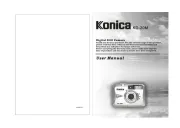
31 Maart 2025
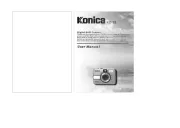
21 Maart 2025
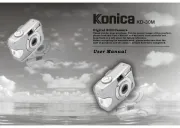
21 Maart 2025
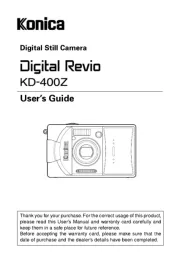
12 Maart 2025
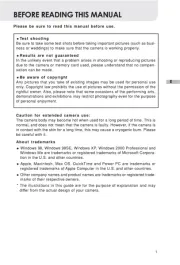
12 Maart 2025
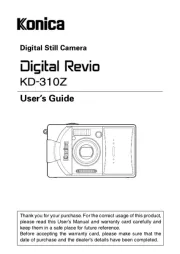
12 Maart 2025
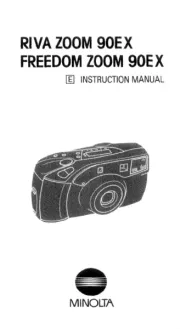
2 December 2024
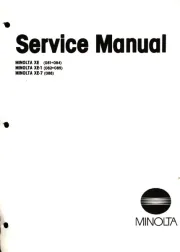
2 December 2024
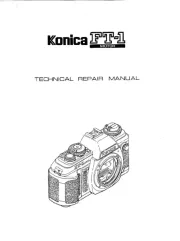
2 December 2024
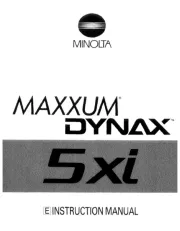
2 December 2024
Handleiding Niet gecategoriseerd
- Schlage
- Svedbergs
- Laine
- Playtive
- Daikin
- Aqua Marina
- KMP
- Revier Manager
- JoeCo
- Purell
- HPRC
- Studiologic
- Maytronics
- Beeitzie
- Baja Mobility
Nieuwste handleidingen voor Niet gecategoriseerd

14 September 2025

13 September 2025

13 September 2025

13 September 2025

13 September 2025

13 September 2025

13 September 2025

13 September 2025

13 September 2025

13 September 2025